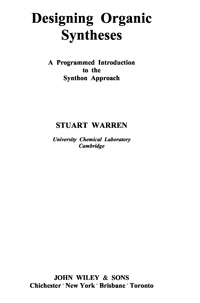Designing Organic Syntheses: A Programmed Introduction to the Synthon Approach
| Автор(ы): | Warren Stuart
06.10.2007
|
| Год изд.: | 1978 |
| Описание: | This programmed book aims to teach students to design organic syntheses for themselves. Almost all available books on synthesis describe methods and syntheses already carried out by others. This book confronts the student with the problem of synthesizing molecules given nothing but their structure. The synthon approach is used: disconnections breaking the molecule into useable fragments (synthons) are introduced to the student who then teaches himself how to use them by solving a series of problems of steadily increasing difficulty. Though the book has the form of a programme it is not a conventional programmed text. There are no multiple choice questions. Instead, the student has a planned sequence of problems designed to demonstrate the use of each new concept and to test his understanding of it. Each problem is followed by possible solutions and full explanations, so that if the student fails to solve a problem he will still understand the answer better for having attempted the problem himself. The student therefore has the possibility of continuous self-assessment through the use of a large number of problems. |
| Оглавление: |
 Обложка книги.
Обложка книги.
How to Use the Programme [2] Why Bother with Disconnections? [2] Glossary [4] A. INTRODUCTION TO DISCONNECTIONS [4] B. ONE-GROUP DISCONNECTIONS [6] 1. Disconnections of Simple Alcohols, frames [10] 2. Compounds Derived from Alcohols, frames [23] 3. Review Problems 1-3, frames [28] 4. Disconnections of Simple Olefins, frames [36] 5. Disconnections of Aryl Ketones, frames [44] 6. Control, frames [49] 7. Disconnections of Simple Ketones and Acids, frames [61] 8. Summary and Revision, frames [73] 9. Review Problems 4-6, frames [78] C. TWO-GROUP DISCONNECTIONS [27] 1. 1,3 -Dioxygenated Skeletons, frames [84] (a) p-Hydroxy Carbonyl Compounds, frames [84] (b) a,p-Unsaturated Carbonyl Compounds, frames [88] (c) 1,3-Dicarbonyl Compounds, frames [94] (d) Review Problems 7-8, frames [108] 2. 1,5-Dicarbonyl Compounds, frames [112] (a) Use of the Mannich Reaction, frames [122] 3. Review Problems 9-11, frames [125] D. ILLOGICAL' TWO GROUP DISCONNECTIONS [42] 1. The 1,2-Dioxygenation Pattern, frames [131] (a) a-Hydroxy Carbonyl Compounds, frames [149] (b) 1,2-Diols, frames [150] (c) Illogical' Electrophiles, frames [158] (d) Review Problems 12-13, frames [167] 2. The 1,4-Dioxygenation Pattern, frames [171] (a) 1,4-Dicarbonyl Compounds, frames [178] (b) y-Hydroxy Carbonyl Compounds, frames [179] (c) Other 'Illogical' Synthons, frames [187] (d) Review Problems 14-15, frames [190] 3. 1,6-Dicarbonyl Compounds, frames [194] 4. Review Section: Synthesis of Lactones, Review Problems [16] E. GENERAL REVIEW PROBLEMS [66] Review Problems [19] F. PERICYCLIC REACTIONS [69] Review Problem [24] G. HETEROATOMS AND HETEROCYCLIC COMPOUNDS [74] 1. Heteroatoms; Ethers and Amines [234] 2. Heterocyclic Compounds, frames [248] 3. Amino Acids, frames [265] 4. Review Problems 25-27 [267] H. SPECIAL METHODS FOR SMALL RINGS: 3- AND 4-MEMBERED RINGS [88] 1. Three-Membered Rings, frames [273] 2. Four-Membered Rings, frames [289] 3. Review Problems 28-30, frames [300] I. GENERAL REVIEW PROBLEMS [98] Review Problems 31 -34, frames [308] J. STRATEGY [101] 1. Convergent Syntheses, frames [309] 2. Strategic Devices. (a) C-Heteroatom Bonds, frames [319] (b) Poly cyclic Compounds: The Common Atom Approach, frames [329] 3. Considering All Possible Disconnections [334] 4. Alternative FGI's Before Disconnection - The Cost of a Synthesis [349] 5. Features Which Dominate Strategy, frames [355] 6. Functional Group Addition, frames [371] (a) Strategy of Satyrated Hydrocarbon Synthesis [380] (b) FGA to Intermediates, frames [381] 7. Molecules with Unrelated Functional Groups [384] K. FURTHER STUDY [391] L. REVISION PROBLEMS, 1-10 [411] M. PROBLEMS IN STRATEGY, 1-7 [419] N. PROBLEMS WITH SEVERAL PUBLISHED SOLUTIONS [424] |
| Формат: | djvu |
| Размер: | 1021694 байт |
| Язык: | ENG |
| Рейтинг: |
334
|
| Открыть: | Ссылка (RU) |